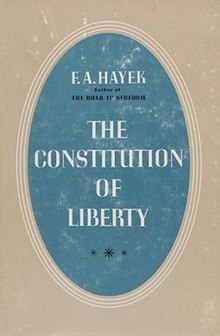The Constitution of Liberty
 First edition dust jacket | |
| Author | Friedrich Hayek |
|---|---|
| Country | United States |
| Language | English |
| Subject | Politics, Economics |
| Publisher | University of Chicago Press (US) |
Publication date | 1960 |
| Media type | |
| Pages | 576 |
| ISBN | 0-226-32084-7 |
The Constitution of Liberty is the magnum opus of Austrian economist and 1974 Nobel Memorial Prize in Economic Sciences recipient Friedrich A. Hayek. First published in 1960 by the University of Chicago Press, the book is considered Hayek’s classic statement on the ideals of freedom and liberty, ideals that he believes have guided—and must continue to guide—the growth of Western civilization.[1] It is an interpretation of civilization as being made possible by the fundamental principles of liberty, which the author presents as prerequisites for wealth and growth, rather than liberty proceeding from wealth and growth. Hayek narrowly defines "Liberty" as absence of coercion by any person or institution.
| Part of a series on |
| Libertarianism |
|---|
The Constitution of Liberty was notably held up at a British Conservative Party policy meeting and banged on the table by Margaret Thatcher, who reportedly interrupted a presentation to indicate, in reference to the book, that "This is what we believe".[2][3][4]
Contents
Part I – The Value of Freedom
- 1. Liberty and Liberties
- 2. The Creative Powers of a Free Civilization
- 3. The Common Sense of Progress
- 4. Freedom, Reason, and Tradition
- 5. Responsibility and Freedom
- 6. Equality, Value, and Merit
- 7. Majority Rule
- 8. Employment and Independence
Part II – Freedom and the Law
- 9. Coercion and the State
- 10. Law, Commands, and Order
- 11. The Origins of the Rule of Law
- 12. The American Contribution: Constitutionalism
- 13. Liberalism and Administration: The Rechtsstaat
- 14. The Safeguards of Individual Liberty
- 15. Economic Policy and the Rule of Law
- 16. The Decline of the Law
Part III – Freedom in the Welfare State
- 17. The Decline of Socialism and the Rise of the Welfare State
- 18. Labor Unions and Employment
- 19. Social Security
- 20. Taxation and Redistribution
- 21. The Monetary Framework
- 22. Housing and Town Planning
- 23. Agriculture and Natural Resources
- 24. Education and Research
Postscript: Why I am Not a Conservative
Reception
The Constitution of Liberty was placed 9th on the list of the 100 best non-fiction books of the twentieth century compiled by the biweekly conservative magazine National Review.[5]
See Also
- The Road To Serfdom (1944), Hayek's most well-known work.
Editions
- 1960. The Constitution of Liberty, Chicago: University of Chicago Press. ISBN 0226320847
- 1960. The Constitution of Liberty, London: Routledge and Kegan Paul.
- 1963. The Constitution of Liberty, London: Routledge and Kegan Paul.
- 1972. The Constitution of Liberty, Gateway edition, paperback. Chicago: Regnery.
- 1976. The Constitution of Liberty, London: Routledge and Kegan Paul.
- 1978. The Constitution of Liberty, Phoenix edition, paperback. Chicago: University of Chicago Press.
- 1990. The Constitution of Liberty, Paperback. London: Routledge.
- 2006. The Constitution of Liberty, New edition, Routledge Classics. London: Routledge.
- 2011. The Constitution of Liberty: The Definitive Edition, Ronald Hamowy, ed., v. 17, The Collected Works of F A. Hayek. University of Chicago Press.
References
- ^ The Constitution of Liberty.
- ^ Berlinski, Claire (December 22, 2011). "Five myths about Margaret Thatcher". The Washington Post.
- ^ Mcdonough, John E. (May 22, 2021). "The Tortured Saga of America's Least-Loved Policy Idea". POLITICO. Retrieved 2022-01-31.
- ^ Feser, Edward (January 28, 2007), "Introduction", The Cambridge Companion to Hayek, Cambridge University Press, pp. 1–12, doi:10.1017/ccol0521849772.001, ISBN 978-0-521-84977-7, retrieved 2022-01-31
- ^ The Editors (3 May 1999). "The Non-Fiction 100". National Review.
{{cite news}}:|last1=has generic name (help)
External links
 Quotations related to The Constitution of Liberty at Wikiquote
Quotations related to The Constitution of Liberty at Wikiquote
